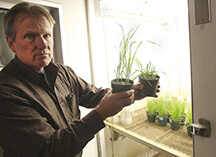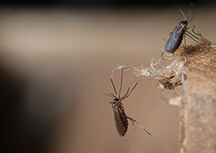Genome reveals how Hessian fly causes galls in wheat
March 2, 2015
 |
|
Purdue entomologist Jeffrey Stuart holds healthy wheat seedlings (left) and wheat seedlings whose growth has been permanently stunted by Hessian fly larvae (right). (Purdue Agricultural Communication photo/Tom Campbell) |
WEST LAFAYETTE, Ind. - A team of researchers from 26 institutions around the world has sequenced the Hessian fly genome, shedding light on how the insect creates growth-stunting galls in wheat.
Hessian fly larvae can destroy entire wheat fields by injecting seedlings with potent saliva that "hijacks" the plants' biochemistry, irreversibly halting development and forcing the seedlings to produce a leaky tissue that contains nutrients for the larvae.
But how the insect is able to slip past plant defenses to create these galls - that is, the plant's stunted growth - has not been well understood.
The genome reveals that the Hessian fly has an extensive reservoir of rapidly evolving genes that code for effector proteins, molecules that control gene expression and cell signaling. The structures of these proteins are remarkably similar to proteins in plants, said study co-author Jeffrey Stuart, which suggests that they mimic normal proteins in the plant cell and use this disguise to manipulate wheat seedling biochemistry.
"The Hessian fly is basically a plant pathogen in the shape of an insect," said Stuart, professor of insect molecular genetics at Purdue. "If we have a deeper understanding of how the insect is attacking the plant and how it avoids detection, we may be able to develop new ways of making resistant wheat more durable and better advise growers on which varieties to plant."
 |
|
A female Hessian fly dangles from fibers on a cardboard box. (Purdue Agricultural Communication photo/Tom Campbell) |
Likely native to the Middle East, the Hessian fly is a pest of global importance. Wheat genetic resistance to the insect is particularly desirable in regions where cultural control methods, such as late planting, are not an option.
"In a few days, a single larva can transform a healthy wheat seedling into one that won't grow anymore," Stuart said.
But wheat is not without its own defenses. Stuart said at least 35 genes in wheat can detect and identify an effector protein injected by the Hessian fly and trigger a counterattack: The plant can thicken its cell wall, preventing fly larvae from extracting nutrients, and produce toxic substances to dispatch the pest. In the southern U.S., some growers use wheat with specific resistance genes to manage Hessian fly.
But the resistance typically fades after 5-10 years as Hessian fly populations that are unable to survive on resistant wheat die off and are replaced by populations with effector proteins that the plant cannot recognize.
Stuart said this "genetic arms race" between wheat and Hessian flies could explain two striking features of the fly genome: the large number of genes - more than 1,000 - that code for effector proteins and the distinctiveness of much of the Hessian fly genome. About 34 percent of the fly's genes bear no similarity to those in other sequenced insect genomes, suggesting that they are rapidly evolving in response to the insect's interactions with plant defense systems.
The reservoir of effector genes also contains the largest gene family discovered in an insect genome.
The next step in the research is to identify the individual proteins injected by the insect and how they work in plant cells, said Purdue doctoral candidate and study co-author Lucio Navarro-Escalante.
"We're just starting to understand how the insect and plant are interacting and which proteins the insect uses to avoid or overcome plant defenses," he said. "In the future, those effector proteins could be the basis from which we generate new ways of controlling the insect."
Stuart said some of the effector proteins closely resemble those in gall-forming bacteria, which could be an example of convergent evolution - a process in which unrelated organisms develop similar features.
Delving into the molecular mechanisms of how the Hessian fly manipulates wheat could help researchers create novel ways of engineering plants, he said.
"Insects have already figured out how to bioengineer plants to make tissues they would not normally produce," he said. "There is no reason why we could not mine the methods of insects to make plants do things for human consumption that they wouldn't normally do."
The paper was published in Current Biology Monday (March 2) and is available at http://www.sciencedirect.com/science/article/pii/S0960982214016959
Funding for the research was provided by the U.S. Department of Agriculture's National Institute of Food and Agriculture, the National Science Foundation, the Swedish Research Council, the Royal Physiographic Society, the Marie Curie International Outgoing Fellowship and the Swiss National Science Foundation.
Writer: Natalie van Hoose, 765-496-2050, nvanhoos@purdue.edu
Sources: Jeffrey Stuart, 765-494-4561, stuartjj@purdue.edu
Lucio Navarro-Escalante, 765-494-1438, navarroe@purdue.edu
Related news releases:
Salivating over wheat plants may net Hessian flies big meal or death: http://www.purdue.edu/newsroom/research/2011/110614WilliamsPermeablili.html
Unusual sex chromosome creates third sex in Hessian flies: http://www.purdue.edu/newsroom/research/2010/100329StuartChromosome.html
ABSTRACT
A massive expansion of effector genes underlies gall-formation in the wheat pest Mayetiola destructor
Chaoyang Zhao 1, 27; Lucio Navarro Escalante 1; Hang Chen 2, 3; Thiago R. Benatti 1, 28; Jiaxin Qu 4; Sanjay Chellapilla 5; Robert M. Waterhouse 6, 7, 8, 9; David Wheeler 10; Martin N. Andersson 11; Riyue Bao 12, 13; Matthew Batterton 4; Susanta K. Behura 14; Kerstin P. Blankenburg 4; Doina Caragea 5, 15; James C. Carolan 16; Marcus Coyle 4; Mustapha El-Bouhssini 17; Liezi Francisco 4; Markus Friedrich 13; Navdeep Gill 18; Tony Grace 5; Cornelis J.P. Grimmelkhuijzen 19; Yi Han 4; Frank Hauser 19; Nicolae Herndon 5; Michael Holder 4; Panagiotis Ioannidis 6, 7; LaRonda Jackson 4; Mehwish Javaid 4; Shalini N. Jhangiani 4; Alisha J. Johnson 20; Divya Kalra 5; Viktoriya Korchina 4; Christie L. Kovar 4; Fremiet Lara 4; Sandra L. Lee 4; Xuming Liu 21; Christer Lofstedt 11; Robert Mata 4; Tittu Mathew 4; Donna M. Muzny 4; Swapnil Nagar 5; Lynne V. Nazareth 4; Geoffrey Okwuonu 4; Fiona Ongeri 4; Lora Perales 4; Brittnay F. Peterson 1; Ling-Ling Pu 4; Hugh M. Robertson 22; Brandon J. Schemerhorn 20; Steven E. Scherer 4; Jacob T. Shreve 1, 29; DeNard Simmons 4; Subhashree Subramanyam 23; Rebecca L. Thornton 4; Kun Xue 24; George M. Weissenberger 4; Christie E. Williams 25; Kim C. Worley 4; Dianhui Zhu 4; Yiming Zhu 4; Marion O. Harris 26; Richard H. Shukle 20; John H. Werren 10; Evgeny M. Zdobnov 6, 7; Ming-Shun Chen 21; Susan J. Brown 5; Jeffrey J. Stuart 1; Stephen Richards 4
1 Department of Entomology, Purdue University, West Lafayette, IN 47907, USA
2 Department of Entomology, Kansas State University, Manhattan, KS 66056, USA
3 The Research Institute of Resource Insects, Chinese Academy of Forestry, Bailongsi, Kunming 650224, People's Republic of China
4 Human Genome Sequencing Center, Department of Molecular and Human Genetics, Baylor College of Medicine, One Baylor Plaza, Houston, TX 77030, USA
5 KSU Bioinformatics Center, Division of Biology, Kansas State University, Manhattan, KS 66056, USA
6 Department of Genetic Medicine and Development, University of Geneva Medical School, Rue Michel-Servet 1, 1211 Geneva, Switzerland
7 Swiss Institute of Bioinformatics, Rue Michel-Servet 1, 1211 Geneva, Switzerland
8 Computer Science and Artificial Intelligence Laboratory, Massachusetts Institute of Technology, 32 Vassar Street, Cambridge, MA 02139, USA
9 The Broad Institute of MIT and Harvard, 7 Cambridge Center, Cambridge, MA 02142, USA
10 Department of Biology, University of Rochester, Rochester, NY 14627, USA
11 Department of Biology, Lund University, 223 62 Lund, Sweden
12 The University of Chicago Bioinformatics Core, Biological Sciences Division, Center for Research Informatics, The University of Chicago, Chicago, IL 60637, USA
13 Department of Biological Sciences, Wayne State University, Detroit, MI 48202, USA
14 Department of Biological Sciences, University of Notre Dame, IN 46556, USA
15 Department of Computer and Information Science, Kansas State University, Manhattan, KS 66506, USA
16 Department of Biology, National University of Ireland Maynooth, Maynooth, Ireland
17 International Center for Agricultural Research in the Dry Areas (ICARDA), Rabat, Morocco
18 Department of Botany, University of British Columbia, Vancouver, BC V6T 1Z4, Canada
19 Center for Functional and Comparative Insect Genomics, University of Copenhagen, Universitetsparken 15, 2100 Copenhagen, Denmark
20 USDA-ARS, Department of Entomology, Purdue University, West Lafayette, IN 47907, USA
21 USDA-ARS, Department of Entomology, Kansas State University, Manhattan, KS 66056, USA
22 Department of Entomology, University of Illinois at Urbana-Champaign, 320 Morrill Hall, 505 South Goodwin Avenue, Urbana, IL 61801, USA
23 Department of Agronomy, Purdue University, West Lafayette, IN 47907, USA
24 College of Life and Environment Sciences, Minzu University, Beijing 100081, China
25 USDA-ARS, Department of Agronomy, Purdue University, West Lafayette, IN 47907 USA
26 Department of Entomology, North Dakota State University, Fargo, ND 58108, USA
E-mail: stephenr@bcm.edu
Gall-forming arthropods are highly specialized herbivores that, in combination with their hosts, produce extended phenotypes with unique morphologies [1]. Many are economically important, and others have improved our understanding of ecology and adaptive radiation [2]. However, the mechanisms that these arthropods use to induce plant galls are poorly understood. We sequenced the genome of the Hessian fly (Mayetiola destructor; Diptera: Cecidomyiidae), a plant parasitic gall midge and a pest of wheat (Triticum spp.), with the aim of identifying genic modifications that contribute to its plant-parasitic lifestyle. Among several adaptive modifications, we discovered an expansive reservoir of potential effector proteins. Nearly 5% of the 20,163 predicted gene models matched putative effector gene transcripts present in the M. destructor larval salivary gland. Another 466 putative effectors were discovered among the genes that have no sequence similarities in other organisms. The largest known arthropod gene family (family SSGP-71) was also discovered within the effector reservoir. SSGP-71 proteins lack sequence homologies to other proteins, but their structures resemble both ubiquitin E3 ligases in plants and E3-ligase-mimicking effectors in plant pathogenic bacteria. SSGP-71 proteins and wheat Skp proteins interact in vivo. Mutations in different SSGP-71 genes avoid the effector-triggered immunity that is directed by the wheat resistance genes H6 and H9. Results point to effectors as the agents responsible for arthropod-induced plant gall formation.
Ag Communications: (765) 494-2722;
Keith Robinson, robins89@purdue.edu
Agriculture News Page

